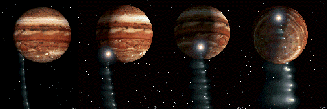How are Comets Relevant to History?
 In the eyes of everyone in about 300 years ago, comets were bad news.
The first references to comets appear in Chinese annals from the 11th
century BC. Right away, comets are regarded as heavenly signs, for good or bad. For example, in Mexico, the Aztec ruler Moctezuma believed that the arrival of the Spaniards was a fulfillment of prophecies brought by comets. He then felt that the heavens had turned against him. In 1066, Harold, the ruler of Saxon England, learns that his kingdom has been invaded by William of Normandy. Many people thought that the comet was a bad omen. However, after Harold was killed in the Battle of Hastings, William claimed that the comet had forecast his success.
In the eyes of everyone in about 300 years ago, comets were bad news.
The first references to comets appear in Chinese annals from the 11th
century BC. Right away, comets are regarded as heavenly signs, for good or bad. For example, in Mexico, the Aztec ruler Moctezuma believed that the arrival of the Spaniards was a fulfillment of prophecies brought by comets. He then felt that the heavens had turned against him. In 1066, Harold, the ruler of Saxon England, learns that his kingdom has been invaded by William of Normandy. Many people thought that the comet was a bad omen. However, after Harold was killed in the Battle of Hastings, William claimed that the comet had forecast his success.
It was until 1577, when the Danish astronomer Tycho Brahe proved
that comets were actually celestial bodies, comets were no longer
regarded as omens from the heaven. In the 17th century, Sir Isaac
Newton showed that the movements of comets referred to the same
laws that control the planets in their orbits. By comparing the
comets' orbital elements (the six parameters that describe the size,
shape and orientation in space of the orbit of a celestial body), Edmond Halley showed that the comet of 1692 was the identical with the other two that appeared in 1607 and 1531. Also, he successfully foretold the return of the comet in 1759. Since about 240 BC. Halley's comet's
orbit has brought it traveling back around the Sun every 76 years.

This photo, taken in New Zealand in 1986,
shows Halley's comet during its most recent pass by earth.
Return to top
COMET SHOEMAKER-LEVY
In 1993, astronomers Carolyn and Eugene Shoemaker and
David Levy spotted a comet with an unusual appearance.
Close-up pictures confirmed that the comet was in fact 21
small comets traveling in a straight line. It was Jupiter's strong
gravity that pulled the original large comet into the 21 parts.
The comet's orbit brought its pieces back toward Jupiter, and in 1994,
the pieces of the comet entered the planet's atmosphere. The gases
around Jupiter sent the 21 pieces to explode into fireballs, which
smashed into the planet over the next few days. A huge explosion was
produced which caused streams of Jupiter's gas to explode into space.

This picture, taken by the Hubble Space
Telescope, reveals the impact sites (dark spots near
the center of the image) created by two fragments of
Comet Shoemaker-Levy 9. Space Telescope Science Institute
Return to top


